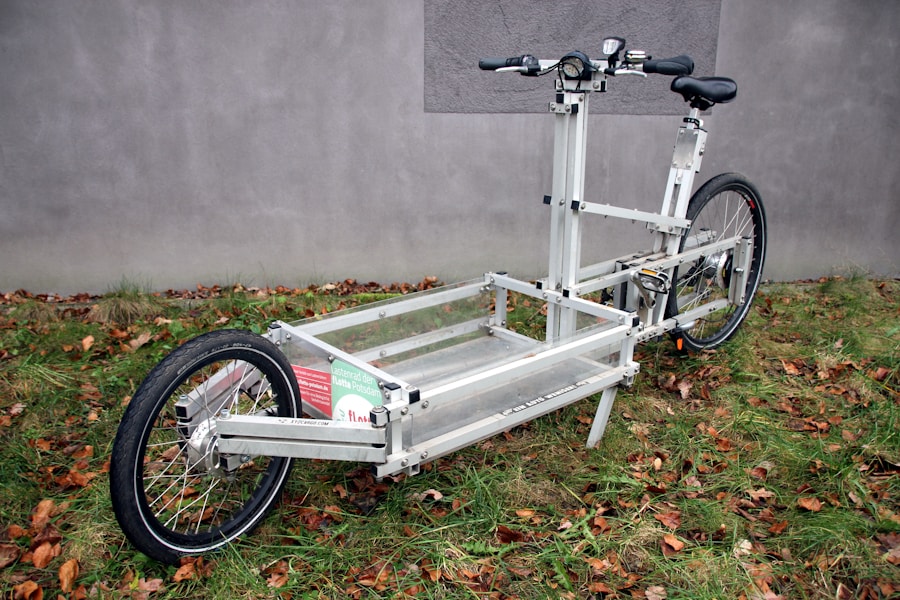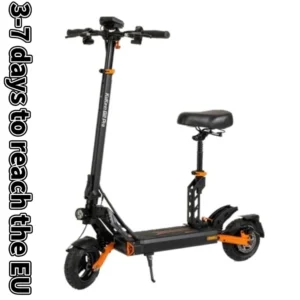Subtotal: 631,24 €
Forvandl din cykel med gør-det-selv elektriske konverteringssæt
Elektriske konverteringssæt er designet til at omdanne traditionelle cykler til elcykler (elcykler), hvilket giver en effektiv og miljøvenlig transportform. Disse sæt inkluderer typisk en motor, batteri, controller og forskellige tilbehør, der er nødvendige for konverteringsprocessen. Den primære appel ved elektriske konverteringssæt ligger i deres evne til at forbedre cykeloplevelsen ved at tilbyde pedalassistance, så rytterne nemt kan klare udfordrende terræn og længere distancer.
Teknologien bag disse sæt har udviklet sig betydeligt, hvilket gør dem mere tilgængelige og brugervenlige for cyklister på alle niveauer. Kernekomponenterne i et elektrisk konverteringssæt består generelt af en navmotor eller en midtermotor, som er ansvarlig for at levere den nødvendige kraft til at drive cyklen. Navmotorer er placeret i hjulnavet, mens midtermotorer er placeret i nærheden af cyklens kranksæt, hvilket giver bedre vægtfordeling og effektivitet.
Derudover er batteriet et afgørende element, da det bestemmer elcyklens rækkevidde og ydeevne. Lithium-ion-batterier er det mest almindelige valg på grund af deres lette natur og høje energitæthed. Det er vigtigt at forstå disse komponenter for alle, der overvejer et elektrisk konverteringssæt, da det giver mulighed for at træffe informerede beslutninger vedrørende ydeevne, kompatibilitet og generel egnethed til individuelle kørebehov.
Vigtige konklusioner
- Elektriske konverteringssæt er designet til at omdanne almindelige cykler til elcykler ved at tilføje en motor, et batteri og en controller.
- Når du vælger det rigtige kit til din cykel, skal du overveje faktorer som motorkraft, batterikapacitet og kompatibilitet med din cykels stel.
- Installation af et elektrisk konverteringssæt involverer montering af motor, batteri og styring samt tilslutning af de elektriske komponenter.
- For at vedligeholde din elcykel skal du regelmæssigt kontrollere og vedligeholde batteri, motor og elektriske forbindelser, og holde cyklen ren og velsmurt.
- Sikkerhedstips til elcykelkørsel omfatter at bære hjelm, følge færdselsreglerne, være opmærksom på dine omgivelser og praktisere sikre kørevaner.
- Fordelene ved elektriske konverteringssæt til cykler inkluderer øget hastighed og rækkevidde, reduceret indsats i pedalerne og evnen til at klare kuperet terræn med lethed.
Valg af det rigtige sæt til din cykel
Kompatibilitet med din cykel
Først og fremmest er det vigtigt at sikre, at sættet er kompatibelt med din cykels specifikationer. Forskellige cykler har varierende stelgeometrier, hjulstørrelser og bremsesystemer, hvilket kan påvirke installationsprocessen og den samlede ydeevne af elcyklen. For eksempel kan en mountainbike kræve et andet sæt end en racercykel på grund af forskelle i vægtfordeling og tilsigtet anvendelse.
Ydeevneegenskaber
Ydeevneegenskaber er en anden kritisk faktor, når man vælger et elektrisk konverteringskit. Motorcyklister bør overveje deres typiske køreforhold – uanset om de skal pendle på flade bygader eller klare stejle bakker – og vælge et kit, der tilbyder tilstrækkelig kraft og drejningsmoment til at opfylde disse krav. For eksempel kan en 250W motor være tilstrækkelig til flad bykørsel, mens en 750W motor kan være nødvendig til terrængående stier eller bakket terræn.
Batterikapacitet og rækkevidde
Derudover spiller batterikapaciteten en væsentlig rolle i, hvor langt du kan køre på en enkelt opladning. Ryttere bør vurdere deres daglige pendlingsdistance og vælge et batteri, der giver en tilstrækkelig rækkevidde uden at gå på kompromis med vægt eller ydeevne.
Installation af dit elektriske konverteringssæt

Installationsprocessen for et elektrisk konverteringssæt kan variere betydeligt afhængigt af de specifikke komponenter, der er inkluderet i sættet, og typen af cykel, der konverteres. Generelt involverer installationen flere nøgletrin: fjernelse af eksisterende komponenter, montering af motoren, installation af batteriet og tilslutning af det elektriske system. For dem, der er fortrolige med grundlæggende mekaniske opgaver, leveres mange sæt med detaljerede instruktioner, der guider brugerne gennem hvert trin i processen.
Det er dog tilrådeligt at have en vis mekanisk viden eller erfaring for at sikre en vellykket installation. En almindelig installationsmetode involverer at udskifte for- eller baghjulet med et hjul, der har en forudinstalleret navmotor. Denne proces kræver typisk at fjerne det eksisterende hjul, fastgøre det nye hjul til motoren og sikre, at det er korrekt justeret og fastgjort.
For centerdrevne motorer kan installationen involvere fjernelse af cyklens kranksæt og krankboks for at få motoren på plads. Efter at motoren er fastgjort, skal rytterne installere batteriet, som ofte er monteret på stellet eller bagpå bagagebæreren. Endelig kræver tilslutning af controlleren og ledningsnettet omhyggelig opmærksomhed for at sikre, at alle elektriske forbindelser er sikre og fungerer korrekt.
Ryttere bør også sørge for at føre ledningerne pænt langs stellet for at undgå potentielle fastklemninger under kørsel.
Vedligeholdelse af din elcykel
| Aspekt | Metrisk |
|---|---|
| Batterilevetid | Typisk 500-1000 opladningscyklusser |
| Dæktryk | Anbefalet 40-65 psi for optimal ydeevne |
| Kædevedligeholdelse | Regelmæssig rengøring og smøring hver 160 km |
| Bremseklodsslid | Udskift hver 1000-2000 miles afhængigt af brug |
| Motorvedligeholdelse | Tjek for snavs og rengør hver 800 km |
Vedligeholdelse af en elcykel er afgørende for at sikre dens levetid og optimale ydeevne. Regelmæssige vedligeholdelsesopgaver omfatter kontrol af dæktryk, inspektion af bremser, rengøring af kæden og overvågning af batteriets tilstand. Dæktrykket bør kontrolleres ofte, da korrekt oppustede dæk forbedrer effektiviteten og håndteringen.
Ligeledes bør bremseklodser inspiceres regelmæssigt for at sikre, at de ikke er slidte og kan give tilstrækkelig bremsekraft. Batterivedligeholdelse er især vigtig for elcykler, da det direkte påvirker rækkevidde og ydeevne. Cyklister bør følge producentens retningslinjer for opladningspraksis; overopladning eller at lade batteriet aflades helt kan forkorte dets levetid.
Derudover kan det at holde batteriet rent og fri for snavs bidrage til at opretholde dets effektivitet. Det er også tilrådeligt at opbevare batteriet et køligt og tørt sted, når det ikke er i brug i længere perioder. Regelmæssig kontrol af forbindelser for korrosion eller skader kan forhindre elektriske problemer, der kan opstå på grund af dårlig kontakt.
Sikkerhedstips til kørsel på elcykel
At køre på en elcykel kommer med sine egne sikkerhedshensyn, der adskiller sig fra traditionel cykling. Et af de vigtigste sikkerhedstips er at bære passende beskyttelsesudstyr, herunder hjelm, handsker og reflekterende tøj. Hjelme er afgørende for at beskytte mod hovedskader i tilfælde af ulykker, mens handsker kan give bedre greb og komfort under cykling.
Reflekterende tøj forbedrer synligheden for andre trafikanter, især under dårlige lysforhold. Derudover er det afgørende at forstå lokale love vedrørende brug af elcykler for sikker kørsel. Mange regioner har specifikke regler vedrørende hastighedsgrænser, hvor elcykler må køres (f.eks. cykelstier versus veje) og aldersbegrænsninger for cyklister.
At gøre sig bekendt med disse love kan hjælpe med at forhindre juridiske problemer og samtidig fremme sikker kørsel. Ryttere bør også øve sig i defensive cykelteknikker ved at være opmærksomme på deres omgivelser og forudse potentielle farer på vejen. Dette omfatter at holde en sikker afstand til køretøjer, tydeligt signalere sving eller stop og være forsigtig i kryds.
Fordele ved elektriske konverteringssæt til cykler

Tilpasningsmuligheder
Derudover giver elektriske konverteringssæt fleksibilitet med hensyn til tilpasning. Ryttere kan vælge komponenter, der bedst passer til deres behov og præferencer, og skræddersy deres elcykeloplevelse til deres specifikke kørestil eller terrænkrav. Dette niveau af tilpasning er ofte ikke tilgængeligt med fabriksbyggede elcykler, som kan komme med faste specifikationer, der ikke imødekommer alle rytteres behov.
Miljømæssig bæredygtighed
En anden bemærkelsesværdig fordel er miljømæssig bæredygtighed. Ved at omdanne en traditionel cykel til en elektrisk cykel i stedet for at købe et nyt køretøj eller være afhængig af biler til korte ture, bidrager cyklister til at reducere CO2-udledning og fremme grønnere transportmuligheder. Elcykler opfordrer også flere mennesker til at cykle ved at gøre det lettere at klare længere afstande eller udfordrende terræn, der ellers ville afholde dem fra at cykle.
En praktisk løsning
Kort sagt repræsenterer elektriske konverteringssæt en praktisk løsning for dem, der ønsker at omfavne elcykling, samtidig med at de bevarer deres eksisterende cykels fortrolighed og komfort. Med omhyggelig overvejelse under udvælgelses- og installationsprocesserne, sammen med korrekt vedligeholdelse og sikkerhedspraksis, kan cyklister nyde alle de fordele, der følger med denne innovative teknologi.
Ofte stillede spørgsmål
Hvad er et gør-det-selv-ombygningssæt til en elcykel?
Et gør-det-selv-konverteringssæt til elcykler er et sæt komponenter, der kan tilføjes til en almindelig cykel for at konvertere den til en elcykel. Disse sæt indeholder typisk en motor, et batteri, en controller og andre nødvendige dele.
Hvordan fungerer et gør-det-selv-ombygningssæt til en elcykel?
Motoren i konverteringssættet er fastgjort til cyklens stel eller hjul, og batteriet driver motoren. Styringen regulerer strømstrømmen fra batteriet til motoren, så rytteren kan kontrollere elcyklens hastighed og ydeevne.
Hvad er fordelene ved at bruge et gør-det-selv-ombygningssæt til elcykler?
Ved at bruge et gør-det-selv-ombygningssæt til elcykler kan cyklister omdanne deres almindelige cykler til elcykler, hvilket giver hjælp til at træde i pedalerne og gør det nemmere at klare bakker og lange distancer. Det tilbyder også en mere overkommelig løsning sammenlignet med at købe en færdigbygget elcykel.
Er gør-det-selv-ombygningssæt til elcykler lovlige?
Love og regler vedrørende elcykler varierer fra sted til sted, så det er vigtigt at tjekke lokale regler, før du konverterer en cykel med et gør-det-selv-elcykelkonverteringssæt. Mange steder anses elcykler med en maksimal hastighed på 32 km/t og en motor med en effekt på 750 watt eller mindre for lovlige til brug på offentlige veje og cykelstier.
Kan nogen installere et gør-det-selv-ombygningssæt til en elcykel?
Selvom nogle gør-det-selv-ombygningssæt til elektriske cykler er designet til at være brugervenlige og nemme at installere, er det vigtigt at have en vis mekanisk viden og færdigheder for at sikre korrekt installation og sikkerhed. Det anbefales at få sættet installeret af en professionel, hvis du ikke er sikker på dine evner.

 Kukirin G2 Pro 600W 48V 15,6Ah 45 km/t 60-80 km 9" foldbar elektrisk løbehjul
Kukirin G2 Pro 600W 48V 15,6Ah 45 km/t 60-80 km 9" foldbar elektrisk løbehjul 